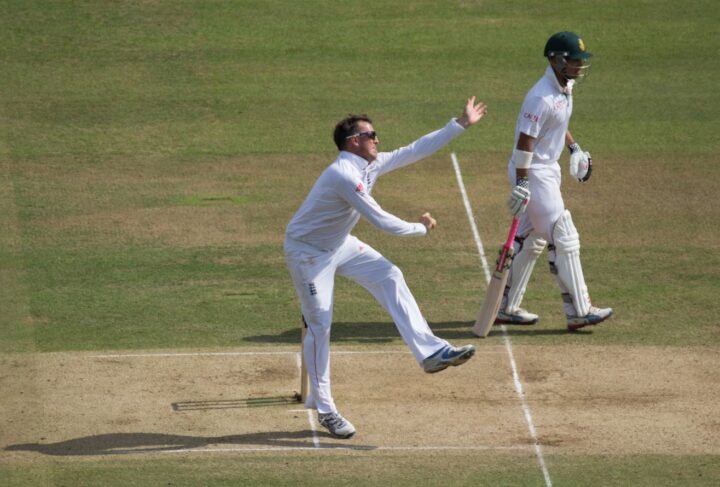As I’m currently writing an article about test cricket’s future for a different forum (I’ll let you know when it’s live), this guest submission from Liam Hope really struck a chord. As a relative newcomer to cricket, Liam has an interesting take on things which reaffirms what I’m sure many of us already think: that test cricket is still a brilliant game with much to offer. I don’t know about you, but I’m tired of hearing that test cricket is fast becoming an anachronism. It’s good to know that it’s still attracting new fans. Anyway, over to you Liam …
Strangely enough my love for cricket- though developed later in life – stemmed from a brief stint on Don Bradman Cricket on the PlayStation 4. I expected to hit immediate boundaries and take a haul of wickets. Unfortunately however, my expectations did not match my ability, and my gaming career produced an array of ducks and edges. My family didn’t take kindly to my bellowing curses which echoed throughout the conservatory.
But despite my frustrations, I quickly became engrossed by the complexities of the game and the patience needed to succeed. My infatuation for cricket has since rocketed and I ended up watching every test match this year. I even made an enjoyable first trip to Lord’s – although my batting average on Don Bradman Cricket remained in the doldrums.
Arguably, my impatience and desire for instant gratification on the PS4 originates from the fast-paced society that we live in, which coincides with the growth of the internet age and the technological revolution. Instant messaging, internet search engines, as well as a host of other functions that can be accessed within milliseconds have naturally affected our psychological approach to everyday life. As a result, both the internet and the growth of modern devices have fuelled society’s desire to achieve fulfilment within an instant. Patience, it seems, has become a thing of the past.
This breeding ground for instant gratification is somewhat embodied by the increasing popularity of T20 – much to the disgruntlement of those passionate about test cricket. In a format where big-hitters thrive, T20 has sold-out grounds and delivered a plethora of sixes and fours. Whilst Scyld Berry has argued that this crowd-pleasing format is vital for the game’s future, it’s disheartening to see the traditional long-format slowly decline. One can assume that Mike Atherton’s defensive style, which once made “batting look like trench warfare”, would no longer appeal in an age where fans yearn for explosive slogs.
Of course, I don’t deny tuning in to the T20 World Cup, and I undoubtedly enjoyed Moeen Ali’s flurry of boundaries during the Edgbaston and Oval tests. In addition, I appreciate that the short format has provided a number of positives: it puts bums on seats and attracts youngsters to the sport. However, despite this I’m concerned about test cricket’s future and I wonder how it can be saved. Already, there have been calls to reduce five-day test matches to four; a change which will shortly be debated by the International Cricket Council.
Moving forward, it is clear that the longer format must have more appeal to wider audiences. Yet, at the same time, perhaps the long-format’s popularity decline has been overstated? For example, the first Pakistan test broke attendance records at Lords. Even Martin Keown fancied a bit of the action as he waited patiently in the queue behind me.
The recent series against Pakistan was a good advert for test cricket. It was an entertaining contest, closely fought, with plenty of highlights and intriguing subplots. Therefore, although test cricket might be a little slow for some, it remains an engrossing sport full of possibilities. An exhilarating ending, or at the very least a gripping narrative, is never more than a wicket or run away.
Liam Hope









A lovely well written piece highlighting the enduring fascination of test cricket and the difficulties it faces in our fast paced, modern world. I’m not much of an online gamer but I’d love a go at Bradman Cricket if I knew where to find it! I’m sure it would increase my credibility no end if I could bowl him out. :-)
You have raised an incredibly important issue that has been, in my opinion, shamefully ignored by cricket fans everywhere. Has any body worked out how to play “Don Bradman Cricket”? (Is it shit or do I have to admit I am just too old for computer games?)
I don’t do computer games and know nothing about Don Bradman Cricket. However, I am amused that it celebrates an icon whose last test match was played nearly 70 years ago. It’s nice that something so utterly modern evokes the history and heritage of the game, even in a small way.
The cynic in me knows full well that they probably named it after the Don because it would’ve presumably cost far too much to obtain the rights to call it (say) Sachin Tendulkar Cricket, but it’s a nice touch nonetheless.
I haven’t owned a games console for 10 years + now.
I used to play Brian Lara cricket, I’m guessing the Don is Australia’s edition?
But that is the greatness of cricket.
For example, what other sport still celebrates players from the 19th century ?
I’m awaiting the arrival of Charles Charlie Charles Football with bated breath.
For sure it’s going downhill. Who has the time to front up for a full day or even two days cricket on a regular basis?
And the batsmen think its 4 one day games not a 5 day game.
To top it off very few matches are close contests where there is genuine tension.
If you want genuine tension reduce the game to 4 days, alter ICC rankings to favour away performances over home performances more clearly, reduce ticket prices (which in AUS are stupidly high) and regulate bat size.
Good thoughts Jeremy. Do you think people are genuinely busier these days? Perhaps during the week but weekends should still be free. It struck me the other day that a test match is a great thing to do with kids because it goes on from 11 until 6. That’s the whole day sorted. I’m not entirely convinced that social changes and today’s fast living is to blame for test cricket’s decline. Others might be able to shed more light though.
What I mean is that modern technology etc should make test cricket more accessible. My own view is that marketing is the problem. We simply don’t market test cricket effectively anymore.
It may not be the cause of its decline but it definitely has parallels.
A lot more people work on Saturdays and certainly Sundays than ever before, they work longer hours in the week if they have the weekend free the spare time is more precious
As for the kids themselves, there is so much more to do now and attention spans are a lot shorter. 10 minutes you tube highlights are probably the way to go to get them interested. We would watch whole sessions/days on free TV (because there was little else)
Statistically, as a nation we work less hours than ever before. The long term trend is for higher wages, shorter hours, greater disposable income and more free time. Its never been easier to watch an entire day of test cricket, and as a result, attendances are actually pretty healthy, despite the extortionate prices, which seem to have doubled in the last few years alone.
PS: This lazy bullshit about modern kids having short attention spans is just ignorant patronising bollocks. Kids today consume test cricket the exact same way I consumed it 25 years ago: they watch a bit, then they go out and play in the garden, then they come back and watch a bit more, etc etc. They would be bored and insulted by 10 minute youtube highlights – the entire point of sport is that it is something you need to watch live.
“T20 has sold-out grounds”.
This is often repeated, but it’s worth some looking at. Firstly, cricket attendances are difficult to find as figures are not routinely published so much commenting on crowds is at best guesswork and at worst the repetition of myths.
Secondly, there is a lot of confirmation bias going on. Reality that doesn’t fit in with an established narrative is just ignored. Test grounds outside the UK are said to be empty. It’s much more complex. On England’s SA tour, over 80k attended the CT Test (which one newspaper spun as a poor crowd) and the Saturday at the Wanderers was sold out. When Australia toured NZ, Christchurch was sold out and the Basin Reserve was packed (although I can’t remember if it was officially a sell-out). The empty ground in SL when they beat Australia in the First Test was takenas proof that cricket is dying there – but Pallekele is a horrible white elephant of a stadium and other grounds in SL like Galle and Colombo are usually well attended. Australia have had some poor crowds at the Gabba but Adelaide, Sydney and the MCG remain well-attended if the opposition are decent. Test crowds have been poor in India but the BCCI treat fans appallingly (for example, tickets not being on sale at the ground or schedules not announced much in advance). Even in UAE, grounds are well-attended at times – especially on Fridays. Only in WI is the situation universally gloomy and there it is more to do with despair at the poorness of the team than lack of interest.
Is T20 as well attended as we’re always told? The T20I WC was played in front of some virtually deserted stadiums. Only matches involving India or West Indies attracted large crowds. They (or Mike Selvey anyway) are always mentioning the 80k who attended the BBL Melbourne derby. What he doesn’t mention are the ticket prices. Tickets can be 10x as much for an ODI as for a BBL game. If the authorities want full stadiums, perhaps they might start by looking at their own price-gouging first?
Lastly, why does it matter? Isn’t it actually kind of rational to prefer to watch a Test in, say, the UAE at home with air-conditioning and shade (especially if you’re watching it on non-FTA TV that you’ve had to pay for anyway). Despite paying lip-service to the idea, the authorities don’t really care much about empty grounds. Cricket gets 90% of its money from TV. Again, we’re in the realm of smoke and mirrors because most of us don’t know what TV companies are willing to pay for different forms of the game. Such care as there is for empty grounds is because they are a turn-off for floating viewers. A full ground is reckoned to attract them because it says something must be good because all these people are watching. Beyond that, nobody in officialdom is bothered.
The two Test matches going on at the moment give some idea of the reality of current Test cricket outside the Big Three.
There’s been no play in Port of Spain for two days. The ground doesn’t even have a super-sopper to assist drying. Durban looks like it’s heading the same way. There hasn’t been an actual rain in Durban since overnight on Day Two but Day Three was abandoned because of a wet outfield and Day Four is heading the same way. Kingsmead does have a super-sopper. However the match is being held in August which is like holding a Test match in England in March. There’s never been a Test in Durban between March and November before – and with good reason. August isn’t that wet a month normally in Durban so there is an element of bad luck but it was also inevitable that if it did rain the ground wouldn’t dry. That’s then combined with a newly relaid outfield that’s a mess….
Tests are being shunted to corners of the schedule so franchise competitions get the best weather. The treatment of NZ, after they gave us one of the best series ever, is particularly appalling. They still only get these two Test series and the next time England play them in 2018 is a bolt-on after the Ashes like England used to treat NZ before the 1980s.
At least Pakistan look like they’ll be top of the rankings in a couple of days….